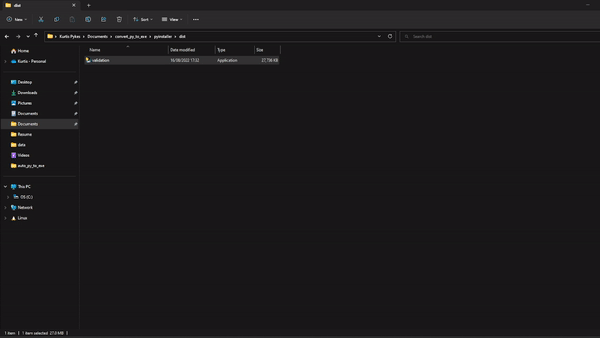Course
In this article, I'll walk you though some of the scenarios that justify converting your Python file to an executable. I'll also demonstrate how to convert a Python file to an executable file using two Python libraries: Pyinstaller and auto-py-to-exe.
Clone this Github repository to follow along with this tutorial.
Why to Convert Python to .exe?
Executable files - files saved with the .exe extension - are used to install or run software applications on computers with the windows operating system. The file that allows a windows computer to run an application is the .exe file.
There are several reasons you may wish to convert a Python program to an executable file. Let’s take a look at a few:
Malicious activity
Unfortunately, some people on the internet like to spread malicious software to infect other people's devices and steal their information. One way to counter these people is to avoid playing into their scams – this means not blindly downloading or opening .exe files that are not from a reliable source.
Accessability
Another reason you may wish to convert a Python file to an executable is to share an application with other users. The typical Python program may consist of several dependencies that another user would need to install before the program can run. What if the person does not know how to code? In such scenarios, expecting a user to learn to code before using an application may be unreasonable. Converting a Python file to an executable file allows users to access your program without knowing Python.
Safeguarding source code
But even if they know who to code, converting a Python file to an executable file may be a good option to prevent your code from being stolen. An executable file prevents code from being stolen because it creates a compiled version of your source code, which makes it harder to comprehend than the actual source code.
Job scheduling
You may also wish to schedule a job on your computer to execute an .exe file at a specific time.
Learn Python From Scratch
How to Convert a Python Script to a .exe File
Now that you know what .exe files are and why you may wish to convert a Python file to a .exe file, let’s look at how to do it in Python. In this section, we will cover two frameworks: pyinstaller and auto-py-to-exe.
This demonstration will use the New York City Airbnb open data dataset.
Before data scientists can analyze a dataset, the data must be formatted to be compatible with the tools they are using. Thus, creating a validation schema effectively defines all the validations that apply to each field declaratively. This process can be quite repetitive. To prevent our data scientists from engaging in repetitive tasks, we’ve created an automated validation script to run periodically.
Note: Be extremely careful when using relative paths if your script must read data. You are better off using absolute paths to ensure your executable works as expected.
import pandas as pd
from pandas.api.types import CategoricalDtype
def perform_validation(filename:str):
"""
A function to validate inputs for NYC Airbnb Open data.
"""
path_to_data = "../.."
data = pd.read_csv(f"{path_to_data}{filename}")
# Convert neighbourhood_group to type category
neighbourhood_group_to_cat = CategoricalDtype(
categories=["Manhattan", "Brooklyn", "Queens", "Bronx", "Staten Island"],
ordered=False
)
data["neighbourhood_group"] = data["neighbourhood_group"].astype(neighbourhood_group_to_cat)
# Convert room_type to type category
room_type_to_cat = CategoricalDtype(
categories=["Entire home/apt", "Private room", "Shared room"],
ordered=False
)
data["room_type"] = data["room_type"].astype(room_type_to_cat)
# Convert last_review to datetime
data["last_review"] = pd.to_datetime(data["last_review"])
# Minimum nights a person can stay is one night
assert data["minimum_nights"].min() >= 1
# Minimum number of reviews is 0
assert data["number_of_reviews"].min() >= 0
# Minimum number of reviews per month
assert data["reviews_per_month"].min() >= 0.00
# Minimum amount of listings per host
assert data["calculated_host_listings_count"].min() >= 1
# Number of days when listing is available for books
# Could be 0 if tennant has long term booking
assert data["availability_365"].min() >= 0
# Save validated data
data.to_csv("validated_ab_nyc_2019.csv", index=False)
if __name__ == "__main__":
# User inputs filename
filename = input("Enter filename: ")
# Ensure it's a string
if not filename.isalpha():
filename = str(filename)
# Automated validation
perform_validation(filename)Note: we have copied and pasted this script into the pyinstaller and the auto-py-to-exe directories.
# Directory structure
| AB_NYC_2019.csv
|
+---auto_py_to_exe
| | requirements.txt
| | validation.py
+---pyinstaller
| requirements.txt
| validation.pyEach directory has there own virtual environment in which we’ve installed the requirements: see pyinstaller requirements or auto-py-to-exe requirements. If you’re following along with the code, be sure to create a virtual environment in the pyinstaller directory and auto-py-to-exe directory.
At a high level, the script above contains a function – learn more about writing functions in Python – that reads in a dataset and then defines the expected format of specific fields in the data. The next step is to convert this Python script into an executable file that could be run periodically to generate a formatted dataset.
Method 1: Pyinstaller
Pyinstaller allows you to quickly convert a Python file to an executable file from your terminal. Once you’ve created your virtual environment and installed the requirements for your script (including pyinstaller), simply open the terminal and navigate to the directory where the Python file you wish to convert is located.
The next step is to run the following command:
pyinstaller --onefile validation.pyInitially, you will see several logs of which the final one will say something along the lines of “completed successfully” – given the executable file is created successfully.

Figure 1: Logs showing the executable file being created and that it is completed successfully.
The completion of this run will create two new directories, build and dist, in the same directory as where the Python file is located. In the dist directory, you will find the validation.exe script.

Figure 2: A GIF demonstrating the execution of validation.exe on a dataset.
To run the script, simply click on it. This will bring up a console that asks you to insert the filename of the data on which you wish to run the validation. Once you enter the file's name, the console will close, and the validated data will be created in the same directory as the validation.exe file – see Figure 2.
Method 2: auto-py-to-exe
The first step to creating an executable file using auto-py-to-exe is to run it using the following command:
auto-py-to-exe This should return a graphical user interface (GUI) that will assist us in converting our Python file to an executable file.

Figure 3: The graphical user interface returned after running the auto-py-to-exe command.
Note: if it’s not working, ensure you’ve created a virtual environment in the auto-py-to-exe directory and installed the requirements.txt in your virtual environment using the following command: pip install -r requirements.txt.
The GUI has several fields we must fill in. Let’s take a look at each one and break do:
- Specific Location: In this field, you must add the script location of the Python file you wish to convert to an executable.
- Onefile: This is where you select whether you wish to create a single directory or file. A single directory will contain all the dependencies required to execute your script and an executable file, whereas selecting “One File” will create a single executable file.
- Console Window: The decision between a “Console Based” or “Window Based” console window depends on what is returned by your script. For example, the script we have created above requires a user to input a filename. Thus, the “Console Based” solution is recommended since this will open the console after running the executable file. If there was no need to display the console outputs after running the executable file then “Window Based” is a good option.
We are also provided with other options to configure the creation of our executable file (i.e. add icons, additional files, and more). In this section, we can also modify the path for where we want to export the files generated by our executable file: to do this, select the “Settings” toggle option and browse to the output directory of your choosing. The last step is to select “Convert .py to .exe” to convert our Python file.
See the GIF in Figure 4 to see how we configured our executable file.

Figure 4: A GIF demonstrating the configuration for auto-py-to-exe
When we navigate back to the auto-py-to-exe directory, there will be a directory called output: this is where our validation.exe file lives. Select the file to run it, which will bring up a console that asks you to enter a filename:

Figure 5: Console returned from running the executable validation file.
Simply enter the file's name – in this example, AB_NYC_2019.csv – and press enter. This will close the console and create a new file in the output directory (where the executable file lives) called validated_ab_nyc_2019.csv.
Conclusion
In this article, you have learned:
- What a Python file is
- What an executable file is and why it may be useful
- How to convert a Python script to an executable using pyinstaller, which is a great tool for those more comfortable with command line operations.
- How to convert a Python script to an executable using auto-py-to-exe, which provides users with a graphical user interface (GUI) to configure how the executable file should be created.
Learn more about how you could leverage Python to do data science in DataCamps Associate Data Scientist with Python career track.
FAQs
Can I include additional files (e.g., images, configuration files) in the executable?
Yes, both pyinstaller and auto-py-to-exe allow you to bundle additional files required by your script. For pyinstaller, you can use the --add-data option to specify files to include. In auto-py-to-exe, there is an option in the GUI to add files under “Additional Files.” Ensure you specify relative or absolute paths correctly so the executable can access these files.
How can I add a custom icon to the executable file?
You can add a custom icon to your executable by specifying an .ico file. For pyinstaller, use the --icon flag followed by the path to your .ico file. In auto-py-to-exe, you can set the icon path in the “Icon” field within the GUI. Note that the icon file must be in .ico format.
Why is my executable file so large, and how can I reduce its size?
Executable files may include all dependencies, libraries, and the Python interpreter, which can make them large. To reduce the size:
- Use the --onefile option in pyinstaller to bundle everything into a single file.
- Exclude unnecessary libraries using the --exclude-module option in pyinstaller or the GUI options in auto-py-to-exe.
- Consider using tools like UPX to compress the resulting executable.
Can I create an executable for a different operating system?
pyinstaller and auto-py-to-exe are platform-specific. To create an executable for a different operating system, you need to use cross-compilation tools or set up a virtual machine or container for the target OS. For example, to create a Windows executable on Linux, you can use Wine or Docker with a Windows environment.
What are the alternatives to pyinstaller and auto-py-to-exe?
Other tools for creating executables include:
- cx_Freeze: A cross-platform tool for creating executables.
- Nuitka: A Python compiler that converts scripts into C code, resulting in faster and smaller executables.
- py2exe: A Windows-specific tool for creating executables from Python scripts.

